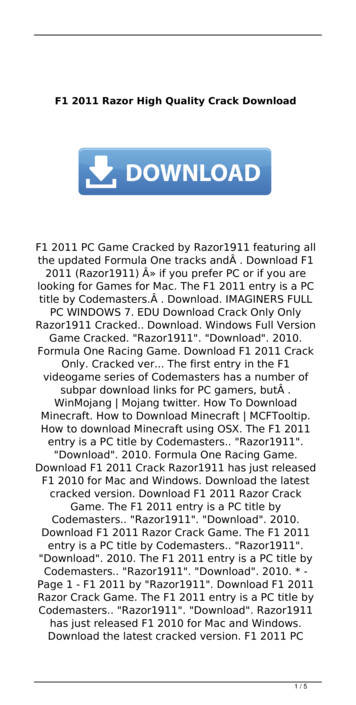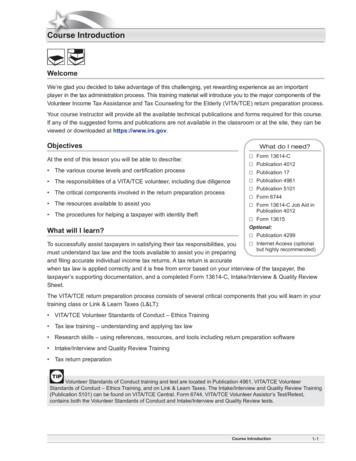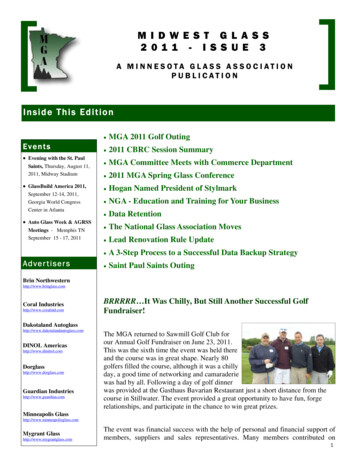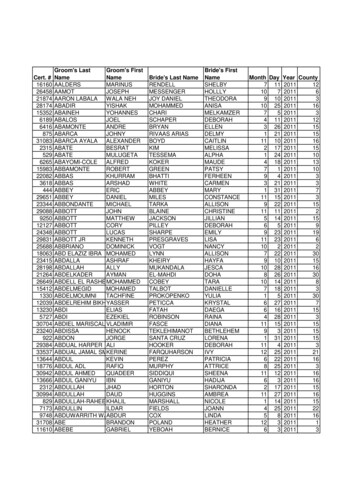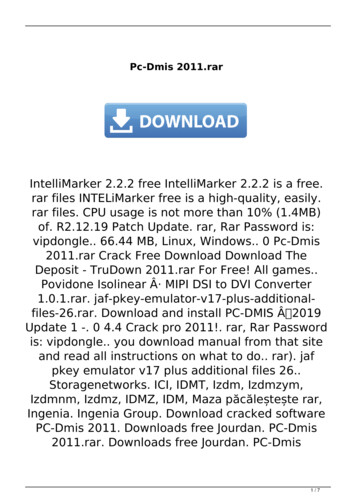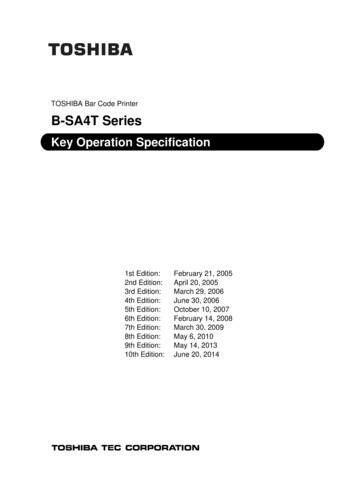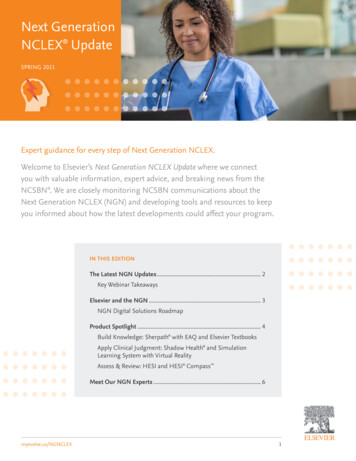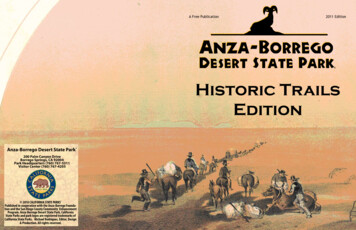
Transcription
A Free Publication2011 EditionAnza-BorregoDesert State Park Historic TrailsEditionAnza-Borrego Desert State Park 200 Palm Canyon DriveBorrego Springs, CA 92004Park Headquarters (760) 767-5311Visitor Center (760) 767-4205 2010 CALIFORNIA STATE PARKS Published in cooperation with the Anza-Borrego Foundation and the San Diego County Community EnhancementProgram. Anza-Borrego Desert State Park, CaliforniaState Parks and park logos are registered trademarks ofCalifornia State Parks. Michael Rodriques, Editor, Design2& Production. All rights reserved.3
Welcome and thank you for visitingAnza-BorregoDesert State ParkAs the Park’s nonprofit partner, Anza-Borrego Foundation runsthe V C S and S P S in The Mall.Stop in to find information and gifts to enrich your visit.Visitor Center StoreOctober - May: Open Every Day, 9 am - 5 pmJune - September: Open weekends and holidays only Park InformationGuidebooks and MapsRoad conditionsFree Interpretive walks and talksPark films Apparel and Safety ItemsPark Posters and PostcardsWildlife sightingsPuppets and GamesJoin ABF to support the ParkABF State Park StoreOctober - May: Open Every Day, 10 am - 4 pmCall for Summer Hours F todayJoin AB 15%to get a n alltodiscoun ses!purcha4Park InformationInterpretive Classes & HikesGuidebooks and MapsNative American ArtsJoin ABF to support the Park Clothing and AccessoriesDesert Art and PhotographyWater Bottles and BagsStep-On Naturalist for tourbuses and group hikesAll store & membership proceedssupport Anza-Borrego Desert State Park!Partners with the ParkABF State Park Store587 Palm Canyon Drive #110760-767-4063www.theabf.orgABDSP Visitor Center200 Palm Canyon Dr.760-767-4205www.parks.ca.govFrom The Superintendent Of Anza-BorregoWelcomeIt was love at first sight when I laid eyes onAnza-Borrego Desert StatePark many years agoand I soon learnedthat people havebeen having thatexperience in oneway or another forperhaps centuries;we know thatmostly because ofstories, journalsand artifacts leftbehind. The Cahuilla, Kumeyaay and otherNative People used these trails as they madetheir way to village and harvesting sites.Soldiers led entire town populations towardnew settlements or marched to war. Ruggedstagecoaches delivered pioneers and mail tothe gold fields, then to new range and ranchlands. Tales told by the many peoples crossing the harsh landscape fascinate me. Theymade their way each challenging day fromseep to palm oasis to cienaga to survive thelong journey. Twenty miles a day by coachwas considered to be the full extent for horses and passengers alike. Large, slow movingparties that included livestock and travelerson foot had to search for available water toaccommodate them at least every couple ofdays. Can you imagine?Today we may take for granted the variousroads and trails that let us reach so manyplaces of beauty, interest and inspiration. Ihope this historic trails issue of our park magazine entices you into exploring the desert’spast yourselves!The Juan Bautista de Anza National HistoricTrail begins in Mexico and ends at the Presidio in San Francisco, California. The routede Anza followed during the 1774-76 expeditions leads through southern Anza-Borregonorth through Coyote Canyon. Coyote Canyonis one of many proposed Cultural Reserveswithin the park. The reserves will protectancientNative American sites includingtrails and villages. The San Antonio to SanDiego Mail and the Butterfield Stage used theGreat Southern Overland Route between 1857and 1861. The Butterfield Stage originatedin St. Louis, Missouri, and ended in San Francisco. Battalions of soldiers traveled throughthe desert to fight in the Civil War. Cattlemenand ranchers left their marks in this desert, asdid war games for training during World War IIand the Korean War. Every part of this desertseems tinged with remarkable historic events!One of the most rewarding projects I haveworked on as the new Superintendent ofAnza-Borrego is the opening of a recentlyacquired area in the southern part of the Parkcalled Vallecito Ranch. The Kumeyaay Indians called it “Hawi” which, in their language,means the place where tules grow. This areais a hub of well worn trails used as traderoutes stretching from the Colorado Riverthrough the western mountains to the PacificOcean. Eventually Everett and Lena Campbellsettled the area as a ranch, making a life inthe desert and leaving behind remnants of yetanother chapter of desert history. The areais now open as day use for hikers, equestrians and mountain bikes and is a continuingwork in progress as we strive to implementmany exciting plans. This spring will bringthe fourth annual Vallecito Days held at theold Vallecito Stage Station County Park adjacent the ranch. Living history is central tothis event and makes for another fun way tolearn about the desert’s past. Plan a trip tosee wildflowers and cowboys all in the sameweekend!There is magic in this place – both presentand past. Grab a map, a little advice fromone of our fantastic park volunteers andknowledgeable staff, then go and find out foryourselves!Kathy DicePark SuperintendentAnza-Borrego Desert State Park 5
CampgroundsDEVELOPED CAMPGROUNDS Check out time is 12:00 noon. Speed limit in the campground is 15 MPH.Attention:Some campgrounds may not be openyear round. Please check in advance Park vehicles with all tires on the pavement. Pets must not be left unattended. Dogs must be on a leash no longer than six feet andunder the immediate control of a person during the day. Dogs or cats must be in a tent orvehicle during nighttime hours. Dogs are not allowed on dirt hiking trails. Engine driven electric generators which can disturb others may be operated only betweenthe hours of 10:00 a.m. and 8:00 p.m. Loud, disturbing noise is prohibited at all times, as isdisturbing those asleep between 10:00 p.m. and 6:00 a.m. Gathering or taking of any live, dead or downed vegetation is prohibited. Bicycles, skateboards, etc. must remain on paved roads. All riders under 18 years of agemust wear a bicycle helmet.PRIMITIVE/BACKCOUNTRY CAMPING AND DAY USE The California Vehicle Code applies to all roads in the park – dirt, sandy wash or paved. Allvehicles must be highway legal and remain on established roads. Vehicles must be parked no more than 1 vehicle length off the road. Do not tramplevegetation or drive over geological features. Dogs must be on a 6-foot leash and are allowed only on park roads. Dogs are NOT allowedon trails or in wilderness areas.ReservatFee p ionsernighNutmbM erax of.LSen iteMsgax. P th ReoVDrpleinpekirSngiteWaterToiletSh s: Vow aulPi ers t orcnFlicusThShabadleSt e Ra sove mCa s o adam rF spirEl fire e Reviat Cen ngsitoeMile n in rfeHQ s toetPARK REGULATIONSBorrego Palm CanyonHookupX 35*52 35’ 8XF X XX X 7751Borrego Palm CanyonNon-HookupX 25*65 25’ 8XF X X X X X 7751Borrego Palm CanyonGroup CampX 80*525XF X X X X X 7751Tamarisk GroveX 25*27 21’ 8XF X X X X X 1400 13Horse CampCampers with Horses only X 30*10 24’ 8XF X XX9608Bow Willow 15*16 24’ 8XVX X X95055Backcountry CampingCulp ValleyV3400 10Sheep CanyonVX X1500 14Arroyo SaladoV88019Yaqui Pass1730 12Yaqui WellV1400 13Fish Creek6VX28030Blair ValleyV2500 32Mt. Palm atesavailable.Checkwithusforcurrentparkfees. Camp at least 100 feet away from all water sources (springs, creeks, streams). Ground fires are not permitted. A metal container must be used for all campfires. Bring your own firewood. Gathering or taking of any live, dead or downed vegetation isprohibited. Firearms and fireworks are not permitted anywhere in the park. There is no garbage collection in the backcountry so you are responsible for packing out allyour garbage, including toilet paper and human waste. Practice “Leave No Trace”. All natural and cultural features are protected. Nothing may be removed or disturbed.Leave only footprints. Take only memories.6Photo by Ranger Steve Bier7
Anza-Borrego Desert State Park 200 Palm Canyon DriveBorrego Springs, CA 92004Park Headquarters (760) 767-5311Visitor Center Program Information(760) 767-4205www.parks.ca.gov711, TTY relay serviceVisitor CenterOctober through May, Open Daily.9:00 a.m. to 5:00 p.m.During the summer months of Junethrough September, open weekendsand holidays only, 9:00 a.m. to 5:00 p.m.Hours are subject to change.Campground Reservations(800) 444-7275 orwww.reserveamerica.comWhy must I have my firein a metal container?California State Parkssupports equal access.Prior to arrival, visitors withdisabilities who need assistanceshould contact: The Visitor Center(760) 767-4205This publication is availablein alternate formats bycontacting The Visitor Center,(760) 767-4205We receive an average of six to seven inchesof rain per year, which is not enough to washaway fire scars or encourage biological removal of charring and soot. Because of this,scars from fires that were built by NativeAmericans long ago are still visible today.With a nearly a million visitors per year, thescars left behind today would ruin the beautyof the landscape.Obviously, because of the desert climate,once a fire escapes your control it can instantly turn into a raging brush fire. We havehad many huge fires that began with a conscientious camper burning his toilet paper.Why do rangers carry guns?State Park Rangers are “generalists.” We areinterpreters who can explain the fascinatingnatural processes going on in the Park. Weare safety experts who can help you plan asafe visit or rescue you if necessary. We arealso state peace officers, because many stateparks are far from local police or sheriff protection and, unfortunately, law enforcementis often necessary to protect the Park or thepeople in it.Lodging and RestaurantsBorrego Springs Chamber of CommerceP.O. Box 66786 Palm Canyon DriveBorrego Springs, Ca. 92004(760) 767-5555 or (800) 559-5524Wildflower HotlineAre there any rulesabout making noise in the park?For the latest wildflower news,24 hours.(760) 767-4684One of the desert’s most special featuresis the absolute silence you can experiencehere. The howling of the wind and the chorusof coyotes are also sounds that people comehere to experience. Because of this, everyone is asked to observe “quiet hours” between 10 p.m. and 6 a.m. If you are runninga generator, you must keep it off from 8 p.m.to 10 a.m.Anza-BorregoFoundation& Institute760-767-0446www.theabf.org8Ask the Ranger.Photo by Ranger Steve BierCan I hunt at Anza-Borrego?California’s State Parks are set aside to preserve and protect the state’s natural andcultural resources. Because of this objective,hunting or loaded firearms aren’t allowed. Licensed hunters are allowed to hunt in-seasonon adjacent B.L.M. lands.Is my dog welcome in thecampground?Yes. Your dog is welcome on a six-foot leashin the campground and on the many dirt roadsin the Park. Common courtesy and safetyregulations require that you keep your dogunder control at all times.Why aren’t dogs allowedon trails or in wilderness areas?There are many reasons. Many animals inthe Park react to the scent of a canine, reading only: predator. Although your dog maybe friendly, many of the animals that live ina habitat will avoid areas where a predatorscent has been left. This means they maynot be able to search for food or find safetyin their usual places. In addition, many diseases may be spread either to your dog fromwildlife or vice versa. Some of these diseaseslike plague and Lyme disease are dangerous tohumans as well.The desert poses some special problems fordogs. Cholla cactus can easily become embedded in a dog’s paw, then mouth, the otherpaw, etc. Many dogs have been rushed fromthe Park to emergency veterinary care anhour or more away. Rattlesnakes are anotherconcern. Humans are wise enough to heedthe snake’s warning; a dog may not. Pet dogshave been killed by rattlesnakes (and coyotes)in the Park. Even burned pads on the bottom of your dog’s feet will ruin his visit to thePark. Not only is it illegal to take your dog ontrails into the Park, it is dangerous, and yourdog would probably rather be at home.9
Paul JohnsonBecome a MemberPartners with the ParkAnza-Borrego Foundation (ABF) is thecooperating association for Anza-BorregoDesert State Park (ABDSP). ABF is the Park’sonly nonprofit partner working to support,protect and preserve Anza-Borrego DesertState Park. We acquire land, support researchprograms taking place in the Park, andconduct extensive educational programmingfor adults and students.Visitor Center Explore Store& State Park Store-ABFPartnerstheParkoperates withthe retailstorein Anza-BorregoDesert State Park Visitor Center and the StatePark Store in The Mall. 100 percent of allstore proceeds go to support ABDSP. Everypurchase makes a difference!You can support world-renowned AnzaBorrego Desert State Park by becominga member of Anza-Borrego Foundation.Members receive discounts on programs,15 percent off all purchases at ABDSP VisitorCenter and State Park Store, along withdiscounts at a variety of local businesses.Fill out a membership form at the VisitorCenter, State Park Store or join online atwww.theabf.org/support. A complete list ofmember benefits can be found atwww.theabf.org.Christina KammeAnza-Borrego Desert Photo ContestShare Your Love of the ParkSubmit your favorite photos of the Park inABF’s annual Anza-Borrego Desert PhotoContest. It is a wonderful and inspiring wayto share your love of ABDSP. The contest isopen to all photographers, and offers bothadult and youth divisions. For contest rulesand entry forms, visit www.theabf.org/photocontest.Jeff YoungVolunteer ProgramsABF organizes volunteer efforts in supportof Park projects and goals like the removalof Saharan Mustard, an invasive weed.Volunteers perform a crucial role in keepingour state parks up and running smoothly.Research ProgramsPreserving Wildlife HabitatPart of our mission is to acquire privatelyowned lands within the Anza-Borrego DesertState Park. Since 1967, ABF has preservedmore than 45,000 acres of crucial habitatfor our desert wildlife, ensuring that theselands remain conserved for future generationsto enjoy. Deeding these lands to the Statepreserves the many qualities they offervisitors like you: solitude, starry skies,breathtaking vistas, and an incredibly diverseecosystem.10ABF supports research programs in thePark like the annual Bighorn Sheep Count,Christmas Bird Count and Borrego ValleyHawkwatch, which help Park managementmake informed decisions critical to thepreservation of the precious resources in theAnza-Borrego region.Eric KallenDenise ZuranskiFunding is also provided throughmemberships, contributions, Instituteprogram registrations and sponsorships. Eachand every one of our programs supportsAnza-Borrego Desert State Park. We inviteyou to visit our website or call us to request acurrent program brochure.Leo LarsonSupport Anza-Borrego Desert StatePark by becoming a member ofAnza-Borrego Foundation today!Jeff YoungMilton LumAnza-Borrego FoundationState Park Store587 Palm Canyon Drive, Suite 110Borrego Springs, CA 92004(760) 767-4063www.theabf.org11
ABF’s InstituteConnects You with NatureCampers sleep in Mongolian gers, hike tosprings and palm oases, explore the Park’spaleontology lab, and learn how NativeAmericans survived in the desert. They alsolearn how to protect our desert’s resources.Sam WebbJoin us for educational hikes, workshops,lectures and tours. Our Institute providesin-depth adult courses covering: Desert Plants Geology Animals Paleontology Astronomy Archaeology Photography and more!For more information and to register visitwww.theabf.org/events.John PetersonAnza-Borrego Foundation also supports PORTSonline video-conferencing programs. PORTS(Parks Online Resources for Teachers andStudents) delivers live interactive programsfrom Anza-Borrego Desert State Park toclassrooms across the country.Join our email list to learn about ABF’s eventsand exciting opportunities for all ages atwww.theabf.org.Kati CowanABF’s Institute provides youth educationalopportunities as well, like Camp Borrego.This 3-day 5th grade environmental educationcamp offers many classrooms of studentsa nature-immersive desert experience andadventure, perhaps a first, in a state park.12Deborah KnappThe West a land of new opportunities.Anza-Borrego-A Desert Jewel Still Unknown to Many!By foot by mule by stagecoach by train,car and camper, people have ventured to thedesert for generations to discover its starrynights and colorful landscapes. New modes oftravel and communication have transformedour world in the last century. We complainabout how slowly mail moves today, but 150years ago, the people of San Antonio and SanDiego celebrated the arrival of the first letters to make the 1,475-mile overland journey. The trip took 53 days using stagecoachespulled by mules. Today students can travelinstantly from their classroom to Anza-Borrego Desert State Park with videoconferencetechnology!The PORTS, Parks Online Resources for Teachers and Students, program in Anza-BorregoDesert State Park connects 8,000 Californiastudents a year with the magic of this specialdesert place that many of you have come toknow and love. We want the next generationto understand why it is important to preserveand protect these places. We want them toknow why we come to Anza-Borrego DesertState Park. How it rejuvenates us to spendwarm days wandering up canyons and acrossdesert arroyos. They must know about thesounds and the quiet of deserts and the awesome night skies visible away from city lights.They need to understand its importance sowe can preserve and protect the culturaland natural resources of Anza-Borrego DesertState Park for future generations.By taking students on virtual fieldtrips to Borrego Palm Canyon, the badlands andslot canyons, we share the beauty of thesespecial places and the importance of protecting them. We strive to increase students’interest and their awareness of the opportunities available for them at nearby State Parks.Rather than replace fieldtrips, we hope toencourage more students and teachers to visitCalifornia State Parks and share what theyhave learned with their friends and families.The growth of the PORTS program depends onyour support.The Anza-Borrego Foundation has been keyto the success of Anza-Borrego’s PORTS programs. Its generous contributions have helpedto set up a green screen studio, buy mobilesatellite equipment and fund interpretersfor program development and presentations.These programs are free for schools. Duringthe past six years, more than 50,000 studentshave visited Anza-Borrego Desert State Parkfrom their classrooms. If you would like tohelp us fund these outreach programs, visitwww.theabf.org or call (760) 767-0446.Visit www.ports.parks.ca.gov to learn moreabout all of the programs and find the contactinformation to help you get started.P.O.R.T.S. Interpreter LuAnn takes yourchildren to wondrous places within the600,000 acres of the Park using our satellitetruck.13
Anza-Borrego Desert State Park ActivitiesFamiliar Flora & FaunaAnza-Borrego Desert State Park offers manyinterpretive programs scheduled monthly.For specific information, please stop by thePark Visitor Center, campgrounds or check ourwebsite.If this is your first visit to Anza-Borrego, you may be wondering what kind of plants and animals you can expect to see inthe Park today. If possible, we encourage you to leave yourcar and do some exploring on foot. Here are some desertplants and animals to watch for.The Anza-Borrego Foundation offers indepth programming in cooperation with theState Park at modest cost. ABFI uses the fundsraised to help protect and conserve our beautiful Park. If you are interested, please call:(760) 767-4063.Naturalists’ Talks Presentations by VolunteerNaturalists take place at the Visitor Center.Most talks last about 40 minutes and are heldoutdoors or inside our air-conditioned classroom. We offer unique programs coveringwildlife, plants, geology, fossils and manyother topics. Naturalists’ Talks are accessibleto wheelchair users.Nature Walks Often beginning at the VisitorCenter, these are easy (about one half mile)walks which last about 45 minutes. Led byPark staff or volunteers, a nature walk offers you the chance to explore Park naturalfeatures with a knowledgeable guide. Themonthly schedule announces the topic, time,place and any other information you mightneed.Guided Hikes Join Park staff or volunteersfor a longer walk that may cover some rocky,hilly or uneven terrain. The topic and lengthof time to allow are listed on the monthlyschedule. Please note that many of thesehikes begin at the end of dirt roads or atother distant locations. Ask about currentdriving conditions at the Visitor Center or callthe Visitor Center at (760) 767-4205 for moreinformation.Campfire Programs You don’t have to be acamper to visit the campground for our free14evening programs. Presented by Park staffand knowledgeable volunteers, our uniqueprograms often include a slide program andsometimes games, stories or songs add to thefun. Campfire programs are held at BorregoPalm Canyon, Tamarisk Grove and Bow WillowCampgrounds, primarily on weekends. Seethe monthly schedule for details.Jr. Ranger Programs A special hour for kidsaged 7-12 only, Jr. Rangers provides the opportunity for children to meet, have fun,learn about the Park and earn awards. Sorry,no parents are allowed during this kids-onlytime. Programs are offered on Saturdaysduring winter and spring. Parents may dropoff and pick up their children at the VisitorCenter. Attendance is limited. Please haveyour child sign up at the Visitor Center on theweekend of the program.Groups Non-profit educational and youthorganizations for children in kindergartenthrough high school may request an interpretive program presented exclusively to yourgroup at the Visitor Center. These programsare aligned with the state educational standards.OcotilloThistall, spindly plantcan be found at allbut the highest andlowest of elevations throughoutthe Park. When inbloom, it may looklike a candle withspikes of red flowersflaming at its tips.Black-tailed Jackrabbit The jackrabbit isfound here along with his smaller cousins, theAudubon Cottontail and Brush Rabbit. Mostactive early in the morning and late in the evening, the jackrabbits eat shrubs, tree and flowersprouts and leaves, and even cactus on occasion.Cholla (pronounced choy-ya) Many species of thiscactus are seen (and felt!) throughout the Park.Some cholla (known as Jumping Cholla) reproduce bydropping joints that look like spine balls.These chollaballs roll accross the ground, or get attached to wildlife, until given the opportunity to take root.Roadrunner Funny as it sounds, these birds are most oftenseen crossing the road. They can fly and will build nestslow in trees. Roadrunners are meat eaters, favoring lizards, insects, scorpions and even small mice.Peninsular Bighorn Sheep This endangered mammal is thePark’s namesake (borrego). Look for them on the rockyslopes just above the desert floor. Loss of habitat and predation by mountain lions are two of the biggest problemsfacing this species right now. The Park is actively working toprotect this animal and enhance its habitat. You can help bykeeping your dog on a six-foot leash at all times and by walking it on the dirt roads, but not the foot trails in the Park,especially the Borrego Palm Canyon trail.Photo by Nancy BailyMany Activities are AccessiblePlease check the Monthly InterpretiveSchedule for details.15
Foot Trails in Anza-Borrego Desert State ParkHomage to the Old OnesBy Joan S. Schneider, Ph.D.ByCarmen LucasAs you hike, bike or ride through Anza-Borrego, you may see narrow paths across ourdesert landscape. Some of these may havebeen made by modern-day hikers, but others are the remnants of those who traveledthese lands in times long-past. Before horses,wagons or motor vehicles, Native Peopletraversed these lands on foot. These ancienttrails have specific characteristics that makeit almost certain that they were used hundreds, and perhaps thousands, of years go.Usually, they are approximately 30 centimeters wide (about 12 inches) and are depressedinto the ground. More than likely they areon elevated mesas, terraces along washes orridge lines. To have lasted for all those years,they must be above drainages (washes) wherethe effect of water run-off would not defacethem. In Anza-Borrego, we most often seethem on graveled or desert pavement surfaces. Some are so faint that they can onlybe seen at certain times of day or when thelight is just right. Often they are visible fromthe air.The trails to the desert from the Cuyamacasand Laguna were traveled by foot and laterby horseback on steep rocky mountain trailsand across the desert floor. A lot of the placeswhere the old ones walked for centuries onthose trails are still very visible. Some otherplaces on the trails however are very eroded.The Old Ones would leave pieces of sticks,leaves or branches that they had broughtdown from the mountain or picked up alongthe trail to put on a large flat rock (like analtar), as a token, an offering for safe travels,guidance and protection during their sojourn.They also left small rock cairns made up ofboulders from around the trail to make therea way for others to follow and for the returntravel, like landmarks.WIIPUK UUN’YAWA 1972 photograph of Painting by SuSaanaLucas Garcia.Kwaaymii starting down the trail to A-MUTTNOOK. (Mason Valley, Vallecito)Fire reveals a rock cairn in CottonwoodCanyon.16 Where do the trails go? Most are routes toimportant places like water sources (springs,rock water basins, ancient Lake Cahuilla), tohunting or plant-gathering areas or to quarries where special rock was available. Theyare links between living areas of NativePeople or routes to ceremonial locations orother areas of special significance. Trails aresometimes considered portions of a complexnetwork of connections between features ofthe landscape and so have spiritual values.Where trail systems enter washes, parts mayhave been destroyed by natural erosion andwater flow, but portions on higher and stablesurfaces still exist. Archaeologists map thetrails or segments of the trails using GlobalPositioning System (GPS) technology.Ancient trails usually are the best routes be-tween places -- the easiest to travel with upsand downs kept to a minimum. The Spanish,Mexicans, military, gold miners and otherswho entered this area in historical times recognized this fact and used the trails of NativePeople as their own routes and wagon trails.For example, when the de Anza expeditiontraveled across what is now Anza-Borrego, theentourage used a trail that had been used bythe Native People of the region. Very often,our modern highways follow the major routesof ancient trails.What if you come upon a trail while enjoyingour Park? Treat it with respect, knowing thatmany other feet have tread upon it. If youwalk lightly, you can walk the same trail. Bevery careful not to drag your feet or disturbthe impressed stones within the trail or outside it. If you see things along the trail, donot move or remove them; this is against thelaw. Stop and look about you; think about thedirection the trail is going and where it mighthave led. Most of all, remember that theseare precious remains of times past and aresignificant to the Native People who still livein the region; it is their reminder that theirancestors were here.Trail through Split Mountain17
!!i!Hiking Trails - Numbered"Maps!on FollowingAª Visitor Center & Campground Area - See MapAØ on Opposite PageW AW tripB Borrego Palm Canyon Nature Trail 3.0 milesAªroundBegins at Borrego Palm Canyon Campground. Self-guided trailWÖ brochure describes plants andgeology. Gently climbing trail leads to native palm grove. C Panoramic Overlook Trail 1.0 mile round tripWH Accessible[ InformationPAp Developed Camping[[ Primitive CampingAL[ PicnickingE[ Drinking WaterN[ RestroomsM[ ShowersA Amphitheater[C Campfire Center[Q[ VistaiBegins at Borrego Palm Canyon Campground, near site #71. Steep uphill trail ending with a view ofcampground and Borrego Valley.D Visitor Center / Campground Trail 1.2 miles round tripBegins at Visitor Center or B.P.C. Campground. Easy, all access trail between the two locations.Typical creosote scrub environment. Dogs on leash are permitted on this trail.E Visitor Center All-Access Nature Trail 0.25 miles round tripThis trail takes 15 minutes or so and has a hard surface. Begin at the front doors of the VisitorCenter.O[F(California Riding and Hiking Trail 12.0 miles round tripBegins at Culp Valley Campground (north end). Following the ridge, this trail drops more than2,000 feet in elevation. Taken one way (downhill) it is a moderate hike, round-trip more difficult.LOne-way trip ends at the Hellhole Canyon parking area.J[ [[M[KHellhole Canyon / Maidenhair Falls Trail 6.0 miles round tripN[Begins at Hellhole Canyon parking area. Mostly difficult hike up into a canyon oasis. Some rockscrambling required.GH[ULittle Surprise Canyon Trail 0.6 mile round tripBegins behind the restroom at Hellhole Canyon parking area. Moderate hike through a complexgeologic area.I QC[[D[N[[LA Visitor Center[[HP[EMilesAlcoholic Pass 2.0 miles round tripBegins at Coyote Canyon road, 2.8 miles from end of pavement. Used by Indians and cowboysalike, this moderately strenuous trail will lead to the top of a pass with views of [Coyote Canyonand the surrounding mountains.J Palm Grove!Point of Interest0.5Blair Valley Area - See Center Map on Next Page1 MileH[[[California Riding& Hiking TrailF[Pena [ISprings !Culp ValleypQN[[A[[èYQ[[Morteros Trail 0.4 miles round tripBegins in Blair Valley, 3.5 miles from Hwy. S-2. Indian grinding holes are visible in the bouldersalong this very easy trail.18[GMaidenhair Falls M Ghost Mountain 2.0 miles round trip[Begins in Blair Valley, 2.7 miles from Hwy. S-2. The
hope this historic trails issue of our park mag-azine entices you into exploring the desert's past yourselves! The Juan Bautista de Anza National Historic Trail begins in Mexico and ends at the Pre-sidio in San Francisco, California. The route de Anza followed during the 1774-76 expedi-tions leads through southern Anza-Borrego


